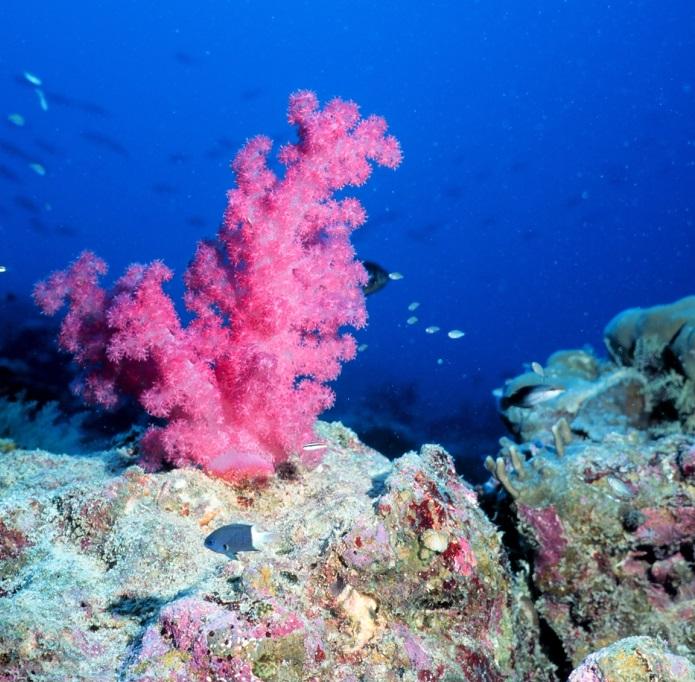Greenhouse gases' millennia-long ocean legacy

Coral near Tarawa, Kiribati. Credit: Taken by Linda Wade; Courtesy of NOAA photo library
Continuing current carbon dioxide (CO2) emission trends throughout this century and beyond would leave a legacy of heat and acidity in the deep ocean. These changes would linger even if the atmospheric carbon dioxide concentration were to be restored to pre-industrial levels at some point in the future, according to a new Nature Climate Change paper from an international team including Carnegie's Ken Caldeira. This is due to the tremendous inertia of the ocean system.
Greenhouse gases emitted by human activities not only cause rapid warming of the seas, but also an unprecedented rate of ocean acidification. Ocean acidification occurs when atmospheric carbon dioxide is absorbed by the ocean and forms carbonic acid, inhibiting coral reef growth and threatening marine life.
Some experts propose that climate and chemical damage due to high levels of greenhouse gases could be avoided by removing active carbon dioxide from the atmosphere, processes broadly called CDR for carbon dioxide removal. One idea is that fast-growing trees such as poplars, which consume a great deal of carbon dioxide during growth, could be farmed and then burned in bioenergy plants where their carbon dioxide would captured and stored underground instead of released back into the atmosphere. However, none of the proposed removal-and-storage strategies have been proven at an industrial scale yet, and ideas such as poplar farming would have to be carefully balanced against land use for food production.
Using computer modeling to investigate the success of CDR strategies, the team discovered that the clock is ticking for CDR to substantially reduce risks to much marine life. If these processes are applied too late, they might as well not be applied at all, as far as ocean acidification is concerned, the team found.
“Geoengineering measures are currently being debated as a kind of last resort to avoid dangerous climate change–either in the case that policymakers find no agreement to cut CO2 emissions, or to delay the transformation of our energy systems,” said lead-author Sabine Mathesius from GEOMAR Helmholtz Centre for Ocean Research Kiel and the Potsdam Institute for Climate Impact Research (PIK). “However, looking at the oceans we see that this approach carries great risks.”
As policymakers consider what might occur if various near- to mid-term climate policy targets are not achieved, it becomes increasingly important to understand what happens if society exceeds these targets.
“If we overspend our carbon dioxide emission budget now, can we make up for it by paying back a carbon dioxide debt later?” asked Caldeira, who worked on this issue during a research stay at PIK. “Can later carbon dioxide removal from the atmosphere offset today's emissions?”
The team conducted a computer experiment and simulated different rates of carbon dioxide extraction from the atmosphere. One of these rates, 22 billion tons per year, would remove carbon dioxide at slightly more than half current emission rates. Another was the probably unfeasible rate of more than 90 billion tons per year, which is more than two times today's yearly emissions. The experiment did not account for the availability of technologies for extraction and storage.
“Interestingly, it turns out that after business-as-usual until 2150, even taking such enormous amounts of carbon dioxide from the atmosphere would not help life that exists deep in the ocean very much. After large-scale ocean circulation has transported acidified water to great depths, it is out of reach for many centuries, no matter how much carbon dioxide is removed from the atmosphere,” Caldeira said.
The scientists' model also looked at increasing temperatures and decreasing concentrations of dissolved oxygen in the sea. Oxygen is, of course, vital for many creatures. The warming reduces ocean circulation, harming nutrient transport. Together with acidification, these changes put heavy pressures on marine life. Earlier in Earth's history, such changes have led to mass extinctions. However, the combined effect of all three factors has not yet been fully understood.
“In the deep ocean, the chemical echo of this century's CO2 pollution will reverberate for thousands of years,” said co-author John Schellnhuber, director of PIK. “If we do not implement emissions reductions measures in line with the 2 degrees Celsius target in time, we will not be able to preserve ocean life as we know it.”
Media Contact
All latest news from the category: Earth Sciences
Earth Sciences (also referred to as Geosciences), which deals with basic issues surrounding our planet, plays a vital role in the area of energy and raw materials supply.
Earth Sciences comprises subjects such as geology, geography, geological informatics, paleontology, mineralogy, petrography, crystallography, geophysics, geodesy, glaciology, cartography, photogrammetry, meteorology and seismology, early-warning systems, earthquake research and polar research.
Newest articles

A ‘language’ for ML models to predict nanopore properties
A large number of 2D materials like graphene can have nanopores – small holes formed by missing atoms through which foreign substances can pass. The properties of these nanopores dictate many…

Clinically validated, wearable ultrasound patch
… for continuous blood pressure monitoring. A team of researchers at the University of California San Diego has developed a new and improved wearable ultrasound patch for continuous and noninvasive…

A new puzzle piece for string theory research
Dr. Ksenia Fedosova from the Cluster of Excellence Mathematics Münster, along with an international research team, has proven a conjecture in string theory that physicists had proposed regarding certain equations….



